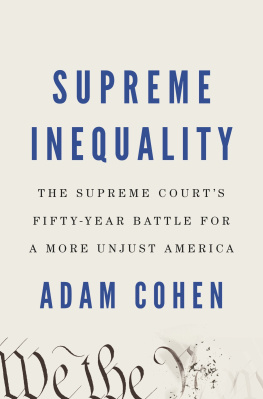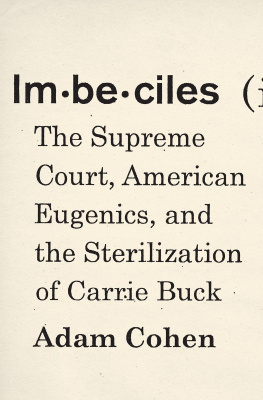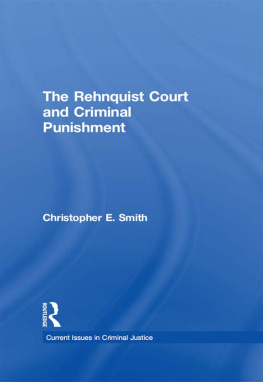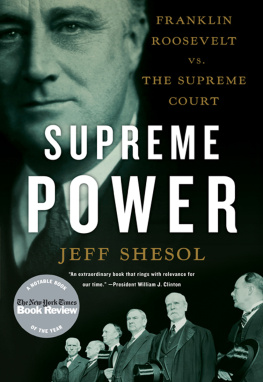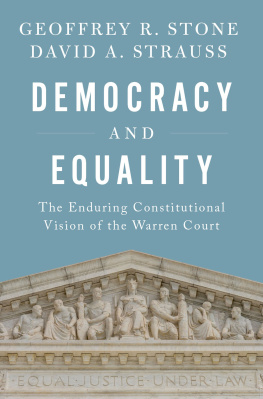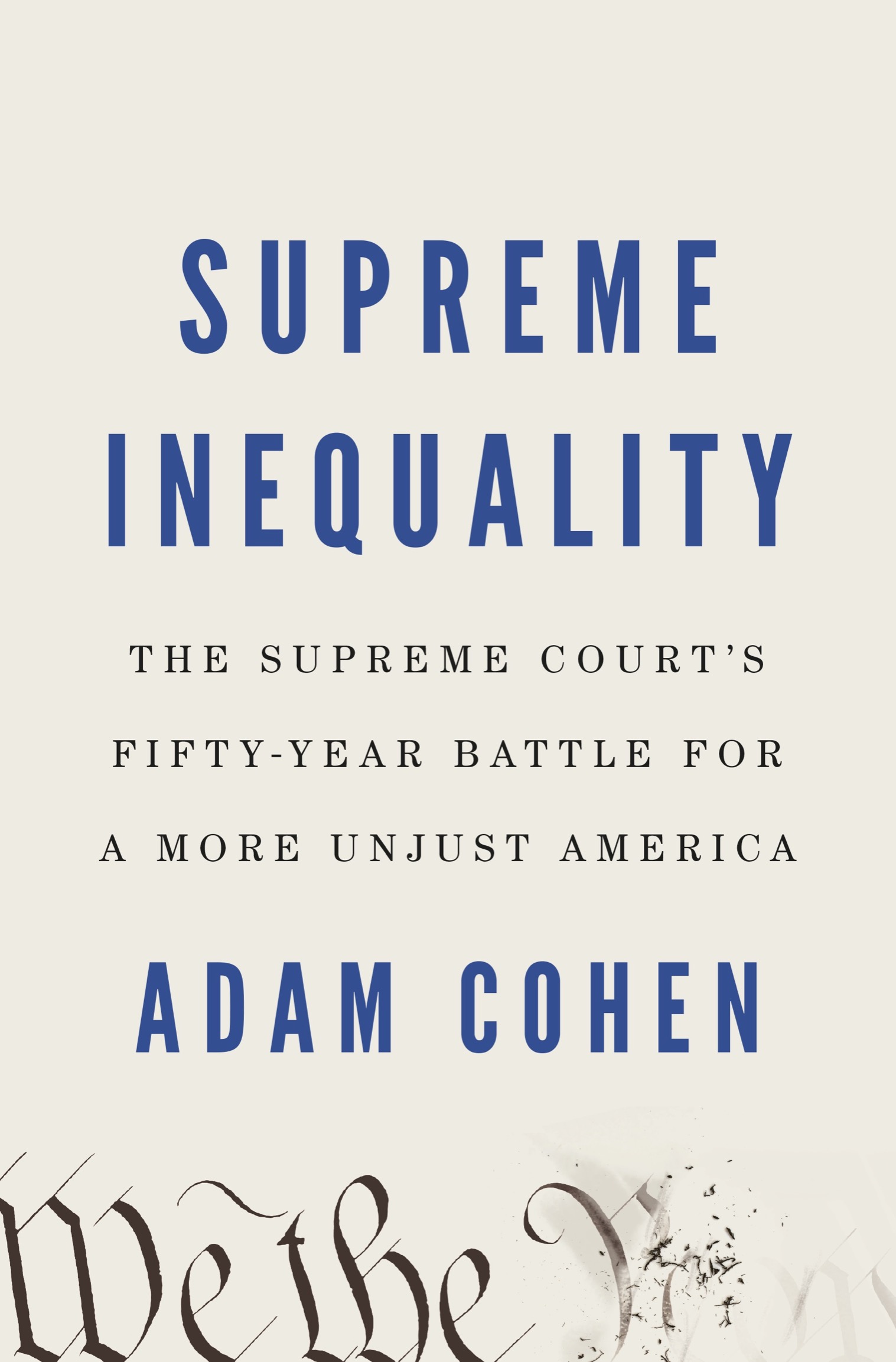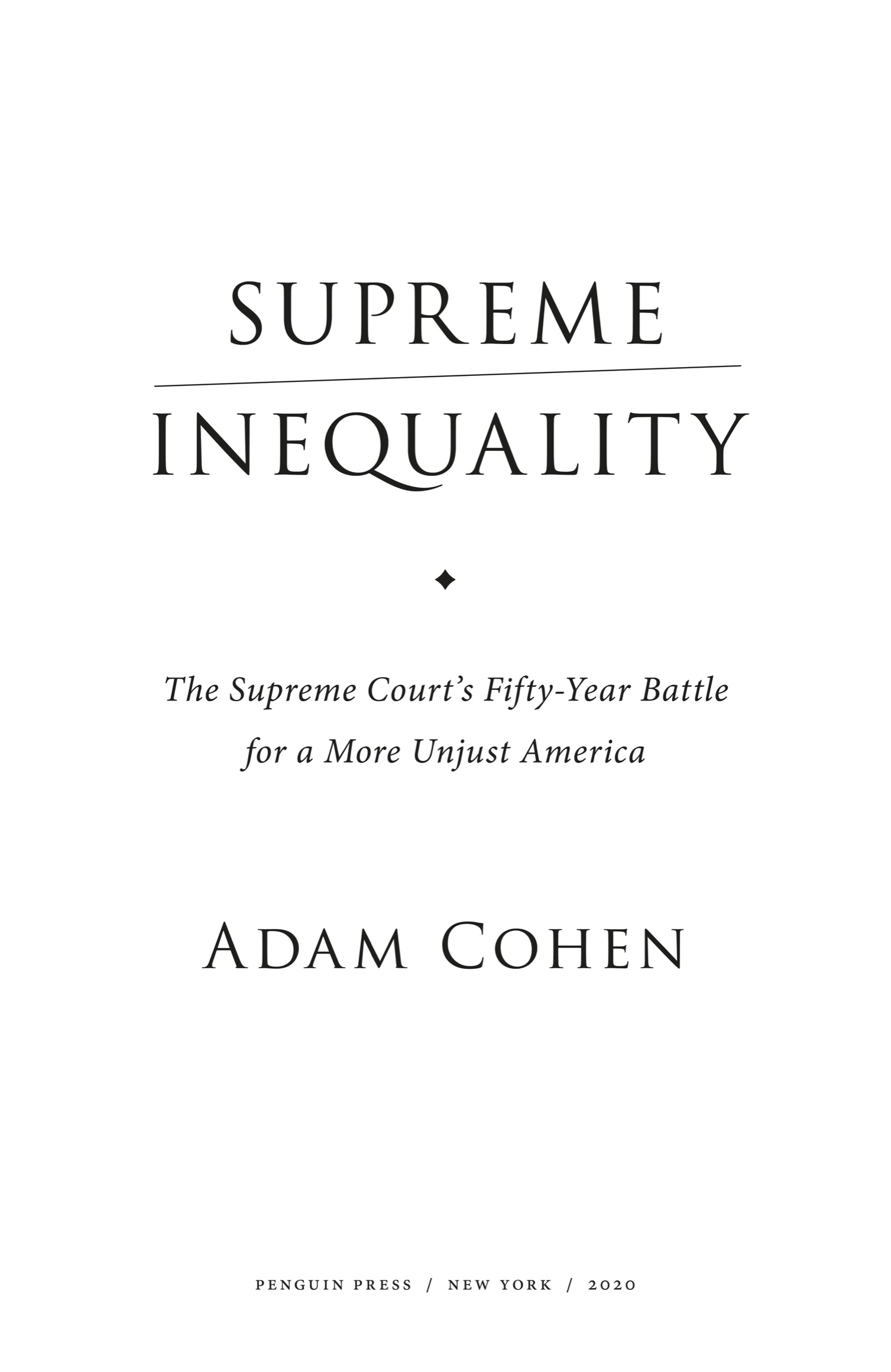Penguin supports copyright. Copyright fuels creativity, encourages diverse voices, promotes free speech, and creates a vibrant culture. Thank you for buying an authorized edition of this book and for complying with copyright laws by not reproducing, scanning, or distributing any part of it in any form without permission. You are supporting writers and allowing Penguin to continue to publish books for every reader.
constitutes an extension of this copyright page.
Names: Cohen, Adam (Adam Seth), author.
Title: Supreme inequality : the Supreme Courts fifty-year battle for a more unjust America / Adam Cohen.
Description: 1st. | New York : Penguin Press, 2020. | Includes bibliographical references and index.
Identifiers: LCCN 2019031002 (print) | LCCN 2019031003 (ebook) | ISBN 9780735221505 (hardcover) | ISBN 9780735221512 (ebook)
Subjects: LCSH: United States. Supreme CourtHistory. | Political questions and judicial powerUnited States. | Equality before the lawUnited States. | DiscriminationLaw and legislationUnited States. | Election lawUnited States.
Classification: LCC KF8748 .C549 2020 (print) | LCC KF8748 (ebook) | DDC 347.73/26dc23
If our civilization is destroyed... it will not be by... barbarians from below. Our barbarians come from above.
INTRODUCTION
Maetta Vance, an African American catering assistant at Ball State University, came to the Supreme Court a few years ago with a case of on-the-job racial harassment. Vance said a white woman who directed her work on a daily basis used racist words around her, including Buckwheat and Sambo, and laughed while her husband and daughter taunted Vance with racial epithets. The woman also slapped her for no reason, Vance said, and later asked her, Are you scared? Vance said a different woman in the department bragged about her familys connections to the Ku Klux Klan and called her a porch monkey.
The Court threw out Vances case, by a 54 vote. Vances lawsuit against Ball State required her to show that the woman who harassed her was her supervisor, but the five conservative justices said she had not done so. As long as the woman could not do things like fire or demote her, the Court said, Ball State owed her nothing. The decision was a clear misreading of the law, and one that bore no relation to how workplaces operate in the real world. Justice Ruth Bader Ginsburg, writing for the liberal dissenters, said a worker who directs another workers daily activities is, of course, a supervisor. She also warned that the Courts decision would make it harder to prevent discrimination from infecting the nations workplaces.
Jack Gross, an Iowa insurance executive, had a similar difficulty with the Court a few years earlier. He was one of a group of high-performing workers over the age of fifty who were demoted by his company on the same day. Gross was forced to hand his responsibilities over to a younger worker he supervised. A jury ruled that he had been a victim of age discrimination and awarded him damages.
The Court overturned the jurys verdict, again by a 54 vote. Gross met the standard of proof required in race and sex discrimination cases. The Court decided, however, that victims of age discrimination had a higher burden of proof, even though the federal laws against race, sex, and age discrimination used identical language. The dissenting liberal justices accused the majority of unabashed... judicial lawmaking.
Then there was Lilly Ledbetter. Ledbetter was a manager at Goodyear Tire & Rubbers plant in Gadsden, Alabama, where for years she was paid far less than the male managers. She had no way of knowing she was underpaid, because the plants salaries were secret, until one day she got an anonymous note telling her. Ledbetter sued for sex discrimination, and a jury ruled in her favor and awarded her damages.
The Court reversed the jurys verdict, again by a 54 vote, with the most irrational reasoning of all. It said Ledbetter had made her claim of discrimination too late. She would have had to file it, the Court said, within 180 days of when Goodyear decided to pay her a discriminatory wage. It did not matter that, at the time, she had no way of knowing how much male managers earned. Ginsburg, in dissent, pointed out that the Court was requiring women suing for pay discrimination to do the impossible. The ruling against Ledbetter was so obviously unfair that Congress overturned it with the Lilly Ledbetter Fair Pay Act, the first law Barack Obama signed as president.
If it seems that the Courts five-justice conservative majority has been twisting the law to rule against employment discrimination victims, there is a simple reason: it has. The Courts battle against victims of on-the-job discrimination is, however, part of a much larger war. For five decades, the Court has, with striking regularity, sided with the rich and powerful against the poor and weak, in virtually every area of the law.
In campaign finance law, it has opened the floodgates to money from wealthy individuals and corporations. In election law, it has upheld rules and practices designed to make it more difficult for the poor and racial minorities to vote, and struck down a key part of the Voting Rights Act. In corporate law, the Court has made it harder for employees and consumers to sue when they are injured. In criminal law, it has favored prosecutors so consistently that it has contributed significantly to the nations mass incarceration crisis. And on a wide variety of issues, the Court has ruled, often cruelly, against the poor.
The financial and emotional toll on the losing parties in these cases has been considerable. Jack Gross was devastated when the Court manipulated age discrimination law to reject his case. One of the things I have always counted on was the rule of law, he said. Gross was also upset that, in addition to losing the damages the jury had awarded him, he was out more than $30,000 in legal expenses. That is money, he said, that was intended to help my grandchildren get a college education so they wouldnt have to starve their way through like I did.
Ledbetter was crushed by her defeat, which she learned about when she was on the way to a church luncheon with her husband, who had been diagnosed with cancer. Id done what I could, she said. Goodyear was simply a greater force than I could overcome. That was clear as day. Ledbetter had not only lost the damages the jury awarded her. It occurred to her that, because her pension and Social Security were tied to her salary, she would continue to be underpaid for the rest of her life.
As shattering as decisions like these have been for individuals, in the aggregate they add up to something much larger: a systematic rewriting of societys rules to favor those at the top and disadvantage those in the middle and at the bottom. The Supreme Court has played a critical role in building todays America, in which income inequality is the largest it has been in nearly a century. The Courts decisions have lifted up those who are already high and brought down those who are low, creating hundreds of millions of winners and losers.

